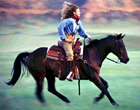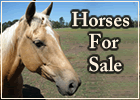

The Courageous Horse
Hi Jeanne,
I congratulate you on doing plenty of homework with your horse to help increase his courage and confidence and to prepare him for possible spooky situations he may encounter on the trail. Of course, we can’t re-create every scary object or situation at home that he might confront out in the real world, but the more strange things you can expose him to at home the more confidence you build in him as long as you introduce these scary things to him with lots of patience and using the approach / retreat method. (See our “Foundation Training” DVD for a full explanation and demonstration of this important technique.)
If you go too fast or too loud with these items or stay too long you could overwhelm him and cause him to fear things instead of building his courage. Try to retreat or remove the item as soon as he is standing calmly, accepting it.
When using tarps, slickers, jugs of rocks, etc. to de-spook your horse, never tie any item to your saddle or to the horse that you want to use for desensitizing. Once you’ve tied an item to your saddle or horse you are no longer in control and cannot remove the item if the horse bolts away from you. In that situation the scary item is chasing the horse and he can’t escape it no matter how many fences he runs through. I’ve had horses brought to me for training that have been totally traumatized in this way. After this kind of horrific experience it takes a long, slow time to rebuild their confidence.
Once your de-spooking work at home is completed and you are ready to head out on the trail it would be a good idea to first pony your horse from a very solid bomb-proof, trail horse. After a horse has been ponied out on the trail a couple of times then begin to ride him behind the same good old experienced trail horse. Ride him with this horse as long as it takes to have him comfortable with the scary items on the trail. While riding with the older horse experiment with your horse riding in front sometimes in order to increase his comfort zone and test his courage.
I don’t mind if a horse spooks occasionally, freezes and needs to look at an item. I’ll sit calmly and give him a minute to examine it and become comfortable with moving along. I don’t look at the item or try to ride him to it and put his nose on it because this would give undue importance to the scary item and prove to him that it really is something that deserves his attention since his leader is also focused on it. Instead, I look on down the trail and ignore the spooky item as if it didn’t exist because eventually that is what I want my horse to do, ignore it and move on.
After he has had a minute to look at it I’ll gently cue him to walk forward with a squeeze and release of my calves. I’ll quit asking as soon as he makes any positive forward movement. If he tries to turn off right or left I’ll have a short rein in each hand and keep him facing the object. If he backs up I’ll use one rein lateral flexion (assuming you are riding in a snaffle bit) and perform a turn on the forehand which disengages the hindquarter and discontinues his backing. If he is very bothered by the item and refuses to move forward I will dismount and try to lead him forward past the scary item then mount and ride back and forth past the item a couple of times still without focusing on the item myself. If you might be in this situation it is a good idea to have your halter and lead rope handy with you when you ride out so you don’t have to pull on the reins and bit when leading your horse from the ground.
We can’t expect our horses to never spook at anything. Even an experienced trail horse is likely to spook at a turkey suddenly flying up in front of him. The following list of suggestions will help you stay safe and stay mounted in case he spooks and whirls away:
- Never grow complacent and assume your horse won’t spook at anything.
- Practice “awareness and prevention” by paying attention and looking far ahead along the trail and surrounding area to determine if you might be approaching any spooky items or wildlife.
- Frequently remind your horse that you are on board and in control by giving him little tasks along the way such as softening to the bit laterally left and right, gait transitions, directing him in specific ways such as left around the tree, right around the rock, leg yield to the other side of the trail, etc.
- Maintain a deep seat that is balanced and anchored from your core with your shoulders behind your hips so if the horse suddenly bolts, spins or stops you just sink deeper into the saddle rather than becoming unseated.
- You should have already taught your horse the emergency one rein stop (lateral flexion combined with hindquarter disengagement) at home so you will have instant control when you need it. (See our “Six Keys to Harmony” DVD for a full explanation and demonstration of this important technique.)
- Never choose to bail off. Grab the horn or saddle and hang on with everything you have. Most of the time, you will be safer staying on your horse and bringing him under control than bailing off. You can’t stop your horse if you’re not on your horse!
A horse that has had the proper foundation training; plenty of de-spooking or desensitizing work; a confident, balanced rider and lots of miles on the trail following behind a solid trail horse and is still very spooky may have a physical or pain issue. Spookiness is related to physical condition because if a horse does not feel completely fit and strong he will have a heightened flight response knowing that his physical limitations, ailment or handicap may prevent him from escaping a perceived danger fast enough to survive.
In the horse’s natural instincts he is not afraid of being hurt, he is afraid of dying. By their nature as a prey animal the horse has a high flight response and a strong survival instinct. In the horse’s eyes perception is reality. We see a harmless plastic bag, he sees an attacking predator. We see a horse trailer, he sees a dark cave where bears live. We see a mud puddle, he sees quicksand or a bottomless pit.
Are all horses just big chickens, afraid of everything? If so, then why does the Bible refer to them in Job 39: 19 – 25 as mighty and courageous? Fear in the horse world is a life and death issue but the horse will face his fear and overcome it for no other reason than his loyalty and trust in his leader. On any given trail ride we may, without even being aware, ask our horse to make several “life and death” decisions – cross this water, walk by that tractor, don’t run from the turkey. The horse would rather flee for his life but just because you asked, he is willing to go forward into what, in his mind, may be certain death. To me, that is true bravery and courage, likely far beyond our own. Would you hold the end of this electric cable that might have 100,000 volts just because I asked you? I might say, “Would you hold this cable? I don’t know if it will kill you or not but would you trust me enough to hold it anyway just because I ask you.” You probably have no desire to hold that cable yet on frequent occasions we ask our horses to make that same reach of faith to step into the unknown and risk death just to go where we ask. This is no minor issue for the horse. It is a life or death decision which takes great faith, trust and courage. How many times a day are you called on to make a life or death decision? Once you understand life from the horse’s point of view you can never let it be said that horses are just big scardey cats. They are certainly not. They are God’s most noble creature- mighty, strong, brave and proud.

Ed Dabney is an internationally acclaimed clinician, presenting horsemanship and riding clinics all over the US and in Europe. In 2007, Ed was named Champion of the East Coast Trainer Challenge Series by Equine Extravaganza. Ed was honored to have been selected by the University of Georgia to teach their senior level Young Horse Training course.
His training articles have appeared in many major national magazines. Ed produces instructional videos and the “Gentle Horsemanship” TV program which has been seen on RFD-TV.
Ed's blending of natural horsemanship and classical equitation has made an indelible mark with students all across the United States and now also in Europe, drawing the attention of serious riders searching for the lightest touch and the deepest connection with their horses irrespective of breed or discipline.


